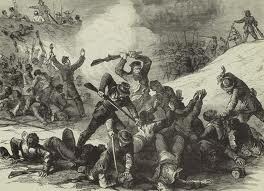Fort Pillow State Park
Introduction
Text-to-speech Audio
Images

1864 image from Harper's Weekly depicts the massacre of Union troops after they had surrendered

Backstory and Context
Text-to-speech Audio
Built in 1861 by Confederate troops, Fort Pillow was named for Confederate General Gideon J. Pillow. Shortly after the fort’s construction, Confederate troops abandoned the fort as the Union army approached along the Mississippi River. The Union army took over the fort leaving it under the command of Major General Stephen A. Hurlbut who was leading the Union in West Tennessee. Four months prior to the infamous Battle of Fort Pillow, also known as the Fort Pillow Massacre, Hurlbut disregarded orders from General William T. Sherman and continued to occupy the fort.
On April 12, 1864 Confederate soldiers led by Major General Nathan Bedford Forrest attacked Fort Pillow which was held by 600 Union troops. The nearly 300 African American Union soldiers were killed at the Battle of Fort Pillow despite the fact that the majority of Union soldiers surrendered as the Confederates approached. The Confederate army lost fewer than twenty soldiers during the encounter. Though Confederate leaders claimed that they had only killed the solders when Union leaders refused to surrender, a federal investigation would later show that both Union and Confederate witnesses testified otherwise.
After the battle the fort was abandoned. Much of the fort was destroyed during the battle and subsequent damage from weather. When the state took over the land in 1971, the inner fort was rebuilt and the outer fortifications were restored. Today, the park’s museum showcases many Civil War artifacts including a canon and interpretive displays relating to the history of Fort Pillow. There is a 12-minute video on the 1864 Battle of Fort Pillow shown by request as well as tours of the museum and restored fortifications. The park also offers a campground with 32 campsites for tent camping. There is a moderately difficult five-mile hiking trail to backcountry camping. Fort Pillow State Park also has a picnic area overlooking Fort Pillow Lake providing visitors with tables and grills.
Cite This Entry
Witten, Laura et. al. "Fort Pillow State Park." Clio: Your Guide to History. May 28, 2020. Accessed April 3, 2025. https://theclio.com/entry/634
Sources
Cimprich, John. Fort Pillow, Tennessee Encyclopedia. March 1st 2018. Accessed May 22nd 2020. https://tennesseeencyclopedia.net/entries/fort-pillow/.
Fort Pillow State Historic Park, Tennessee State Parks. Accessed May 22nd 2020. https://tnstateparks.com/parks/info/fort-pillow.
Glaze, Robert L. Fort Pillow Massacre, Encyclopedia Britannica. April 5th 2020. Accessed May 22nd 2020. https://www.britannica.com/event/Fort-Pillow-Massacre.
History.com Editors. Fort Pillow Massacre, History. June 21st 2019. Accessed May 22nd 2020. https://www.history.com/topics/american-civil-war/fort-pillow-massacre.
https://tnstateparks.com/parks/info/fort-pillow
https://tennesseeencyclopedia.net/entries/fort-pillow/

